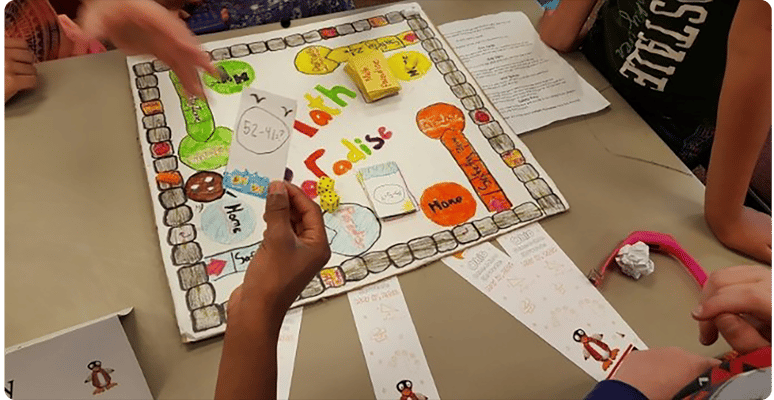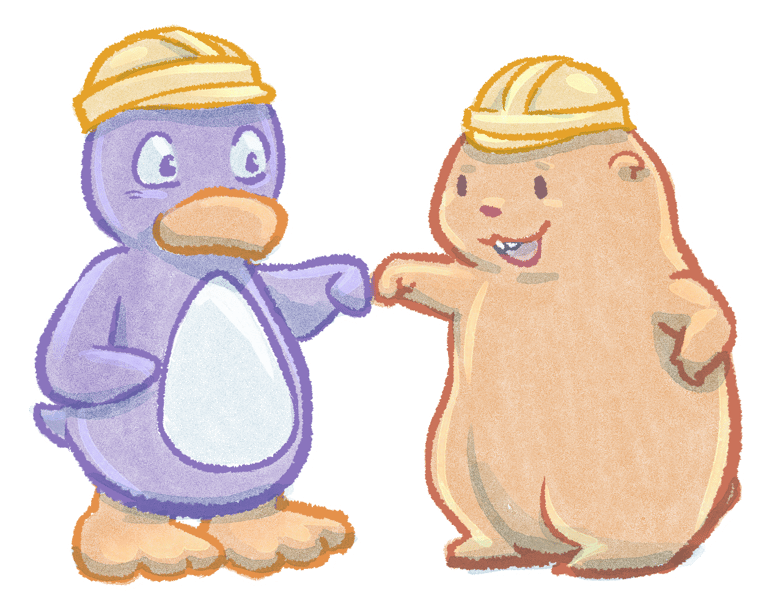This Play.Create.Share. curriculum leverages the inherent enjoyment of games to stories to give students a socially-minded project that builds their ability for self-directed work and creative problem-solving.
So far through Mass STEM Week, we've received nearly 100 student-made games featuring hundreds of student makers. There simply are too many great games to feature every single one. Below are several student highlights - each featuring a different math concept, strategy, and creativity of materials used.
Designed by a 5th grader for the entire family to play. Ideal for 1 to 5 players, use math to be the first to the finish line and save your turtles.
Highlight: Level playing field so adults and kids can play together.
A game of addition and subtraction that wasn't quite right the first time.
Highlight: Iteration
Quote by the game maker:
My first idea was to make a game with an aquarium background. Then, I needed to focus on the game first, and the look after.
In this twist of the numeric version of Achi, certain locations allow for teleportation and others for double stacking.
With these twists, the number combinations for both winning and blocking completely change your gameplay strategy.
Highlight: Great strategic math twist
Made by several students, this multiplayer game involves building expressions and offers an interesting use of a turtle's ability to be on land and in the water. Get stuck in the pond and your turtle needs to roll a 6 to get back to land.
Highlight: Multiplayer game. Leveraging a real-life connection (amphibians ).
Instead of creating an "ideal" game in this student's mind, this student created for a 7-yr old brother and 6-yr old sister.
Highlight: Designed for a specific, authentic audience.
Quote from the game maker:
I didn’t really make the game I wanted to like a super hard mind blowing game. I wanted to be able to play the game with my siblings.
This kindergartener created a memory game using household items. This let's the game be about as simple to DIY as possible.
Study the items, cover them up and describe them in as much detail as possible. Increase the number of items or make different items as similar to each other as possible.
Highlight: Excellent DIY while keeping the game tricky, but fun.
The project is designed as a 10-hr curriculum, but is completely customizable to fit your needs. See our downloads for more about the 10-hr project as well as example 5 and 12-hr adaptations.
To play, use our MathMINDs Games and select the grade-appropriate content. Make sure students have access to the games and then have them start on the storybooks.
Use the games as a family night or math week. Incorporate them into your classroom schedule, assign the games as homework or invite another grade or class to join you for a cross-grade gameplay.
If this is your first project, we recommend the following games.
Kinder - 1st: Kraal Animals I and II
2nd - 3rd: Achi and then Turtle Sums
4th - 5th: Turtle Sums and then Cannonball
This hour is a copy of Hour 1. If you haven’t already, move on to the second game in your grade band or play the additional modes of the games.
As time allows, begin talking with students about what makes games fun, when they stop being fun, and what they like or not about various games (not just math games). This helps them begin to think about making their own fun game.
Whether two hours or five, the play phase has two specific goals.
Read and discuss the Maker Story as a class and then give out your specific maker challenge. Use our stock maker challenges or leverage our checklist to make your own.
We like teams of two. Students get feedback through conversation and divvy up responsibilities without getting lost in the shuffle of a large group.
Your First 20-minutes
Encourage students to focus on their gameplay ideas first. They'll have plenty of time later to maker their games look nice.
* You don't need a ton of supplies. Have kids find or make whatever they need. This way they aren't distracted by the "cool new stuff". Too many supplies early on has a tendency for students to focus on the look and feel of the game, not the strategy.
Kick off each of the next three sessions with a 20-minute lesson. The three topics are design, feedback, and struggle.
Only use the lessons as necessary and change their order based on need. To save class time, assign them as homework, if you want.
Your First 20-minutes

To better understand these lessons, check out the teacher video.
Giving and receiving feedback is the single most important part of the project. After using this hour to practice learning from feedback, infuse it throughout the rest of the project.
A good goal for your first project is for students to make three meaningful iterations on their game based on testing and feedback.
Your Hour at a Glance
Like before, go through the 20-minute lesson. This time, the lesson is on struggle. Then have kids continue to refine and edit their games; play-testing and getting feedback.
If you want, invite another class or grade to be guinea pigs now that students have practiced feedback in Hour 5.
It's time for your students to implement any final changes to their gameplay strategy and make their game pop.
Kids tend to find this to be the most natural part of the project, so much so that they want to rush through iteration because they feel the greatest excitement and ownership when putting their own mark on the game. By not shortchanging this portion of the project, it's easier to keep students focused on feedback and iteration early on.
If you need more time, take it. Hour 9 is your buffer.

Consider how you want the students to share their games - with another class or grade, as your school's family night or open house, in the gym or cafeteria for the whole school to enjoy, with a neighbor or people outside of school, etc.
Use the gameplay form to gauge how well students accomplished the original maker challenge and to gather raw data for Hour 10. If you want, make your own form and put it online for your class to access.
Make this phase as long as you want, kids naturally want to share games with others, so don't rush this phase either.
If you need more time, take it. Hour 9 is your buffer.
This hour is anticipated as a bleed over of hours 7 and 8.
If you don't need the spill over, perhaps you can

Your students are now math game makers! It's time to look at their gameplay data and reflect on the project.
Use this time to have students analyze their data and interpret that data contextually based on the maker challenge. Use our reflection questions if you want.
Consider our ongoing Game-a-thons as an expansion opportunity.


